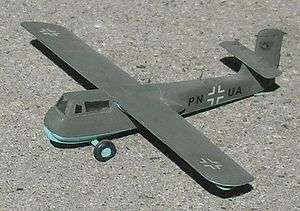Blohm & Voss BV 40
| BV 40 | |
|---|---|
 | |
| Model of a BV 40 | |
| Role | Fighter glider |
| Manufacturer | Blohm & Voss |
| First flight | 6 May 1944 |
| Number built | 7 |
The Blohm & Voss BV 40 was a German glider fighter designed to attack Allied bomber formations during the time of the bombing raids over Nazi Germany.
Design
The BV 40 was the smallest glider that could accommodate an armoured cockpit and two cannon with limited ammunition. By eliminating the engine and lying the pilot in a prone position (i.e. on his front), the cross-sectional area of the fuselage was much reduced, making the BV 40 harder for bomber gunners to hit.[1]
The plane was designed to use non-strategic materials and to be built in as short a time as possible by non-skilled workers. The fuselage was constructed almost entirely of wood. [2]
Of conventional layout, the glider had a high-mounted, straight untapered wing with a similarly-shaped tailplane mounted on the fin just above the fuselage. The pilot lay in the nose of the aircraft, with a thick armoured glass windscreen panel that gave the aircraft a blunt-nosed appearance.
Two 30 mm (1.18 in) MK 108 cannon were mounted in the wing roots.
There was no conventional undercarriage. A twin-wheeled dolly was used for take-off and dropped once the glider was airborne. A skid under the nose was lowered for landing.
History
The BV 40 interceptor glider was conceived as a low-cost emergency solution to the problem of the Allied bomber formations which were devastating Germany in the latter half of World War II. It was to be towed by a Messerschmitt Bf 109 to operational altitude and released above the Allied bombers combat box. Once released, it would dive down at a sharp angle towards the enemy bomber fleet. During its short attack time, the BV 40 would fire its weapons, then glide back to earth.
Several prototypes were completed and flown, towed behind a Messerschmitt Me 110. The first flight took place in May 1944. Various changes to the requirement and to the design were discussed, before the project was cancelled later in the year. In all, seven aircraft were completed and five of them flown.
Owing to the potential dangers for the pilot inherent in the operation of this precarious aircraft, the BV 40 is sometimes listed as a suicide weapon, but it was not intended as such.[3]
Specifications
Data from Warplanes of the Third Reich[4]
General characteristics
- Crew: One pilot
- Length: 5.70 m (18 ft 8½ in)
- Wingspan: 7.90 m (25 ft 11 in)
- Height: 1.63 m (5 ft 4⅛ in)
- Wing area: 8.70 m2 (93.6 ft2)
- Empty weight: 838 kg (1,844 lb)
- Gross weight: 952 kg (2,094 lb)
Performance
- Maximum speed: 900 km/h (560[5] mph)
Armament
- 2 × fixed, forward-firing 30 mm (1.18 in) Rheinmetall Borsig MK 108 cannon (35 rpg)
See also
Related lists
References
Notes
- ↑ Blohm und Voss BV 40
- ↑ Ford, Roger (2013). Germany's Secret Weapons of World War II. London, United Kingdom: Amber Books. p. 224. ISBN 9781909160569.
- ↑ German Suicidal Aircraft
- ↑ Green 1972, p. 102.
- ↑ In a dive.
Bibliography
- Green, William. War Planes of the Second World War, Volume One: Fighters. London: Macdonald & Co.(Publishers) Ltd., 10th impression 1972, pp. 78–79. ISBN 0-356-01445-2.
- Green, William. War Planes of the Third Reich. New York: Doubleday, 1972. ISBN 0-385-05782-2..
- Green, William and Swanborough, Gordon. The Complete Book of Fighters. New York:Smithmark, 1994. ISBN 0-8317-3939-8.
- Smith, J. Richard and Kay, Anthony. German Aircraft of the Second World War. London: Putnam 7 Company Ltd., 3rd impression 1978, pp. 84–88. ISBN 0-370-00024-2.
- Wood, Tony and Gunston, Bill. Hitler's Luftwaffe, a pictorial history and technical encyclopedia of Hitler's air power in World War II. London: Salamander Books, 1977, p. 138. ISBN 0-86101-005-1.
External links
| Wikimedia Commons has media related to Blohm & Voss BV 40. |
- Good Photos of BV 40V1 (in German)
- Blohm & Voss BV40 Glider aircraft (in Russian)